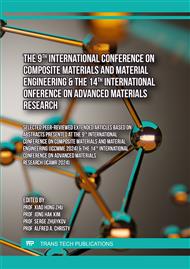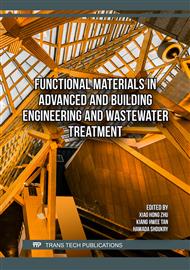[1]
K. L. Law, N. Starr, T. R. Siegler, J. R. Jambeck, N. J. Mallos, and G. H. Leonard: Sci. Adv. Vol. 6 (2020), p. eabd0288
Google Scholar
[2]
S. B. Borrelle, J. Ringma, K. L. Law, C. C. Monnahan, L. Lebreton, A. McGivern, E. Murphy, J. Jambeck, G. H. Leonard, M. A. Hilleary, M. Eriksen, H. P. Possingham, H. De Frond, L. R. Gerber, B. Polidoro, A. Tahir, M. Bernard, N. Mallos, M. Barnes, and C. M. Rochman: Science Vol. 369 (2020), p.1515–1518
DOI: 10.1126/science.aba3656
Google Scholar
[3]
A. Milbrandt, K. Coney, A. Badgett, and G. T. Beckham: Resour. Conserv. Recycl. Vol. 183 (2022), p.106363
Google Scholar
[4]
D. Ghernaout and N. Elboughdiri: Open Access Libr. J. Vol. 8 (2021)
Google Scholar
[5]
M. T. Prasertwit and A. P. D. K. Kanchanasuntorn: NVEO - Nat. VOLATILES Essent. OILS J. NVEO (2021), p.8259–8268
DOI: 10.53555/nveo.v8i4
Google Scholar
[6]
D. K. Le, R. I. H. Leung, A. S. R. Er, X. Zhang, X. J. Tay, Q. B. Thai, N. Phan-Thien, and H. M. Duong: Waste Manag. Vol. 100 (2019), p.296–305
DOI: 10.1016/j.wasman.2019.09.031
Google Scholar
[7]
Y.-C. Jang, G. Lee, Y. Kwon, J. Lim, and J. Jeong: Resour. Conserv. Recycl. Vol. 158 (2020), p.104798
Google Scholar
[8]
R. Geyer, J. R. Jambeck, and K. L. Law: Sci. Adv. Vol. 3 (2017), p. e1700782
Google Scholar
[9]
Information on https://www.statista.com/statistics/282732/global-production-of-plastics-since-1950/
Google Scholar
[10]
S. Yin, R. Rajarao, B. Gong, Y. Wang, C. Kong, and V. Sahajwalla: J. Clean. Prod. Vol. 211 (2019), p.321–329
Google Scholar
[11]
Information on http://infofile.pcd.go.th/mgt/PollutionReport2015_en.pdf
Google Scholar
[12]
Information on https://www.epa.gov/facts-and-figures-about-materials-waste-and-recycling/ containers-and-packaging-product-specific-data
Google Scholar
[13]
Information on https://www.statista.com/statistics/
Google Scholar
[14]
R.-U.-D. Nassar, P. Soroushian, and M. Sufyan-Ud-Din: Case Stud. Constr. Mater. Vol. 15 (2021), p. e00745
Google Scholar
[15]
Q. Song, X. Zeng, J. Li, H. Duan, and W. Yuan: Environ. Sci. Pollut. Res. Vol. 22 (2015), p.12366–12373
Google Scholar
[16]
D. Chen, H. Masui, H. Miyoshi, T. Akai, and T. Yazawa: Waste Manag. Vol. 26 (2006), p.1017
Google Scholar
[17]
L. Liu, G. Cai, J. Zhang, X. Liu, and K. Liu: Renew. Sustain. Energy Rev. Vol. 126 (2020), p.109831
Google Scholar
[18]
B. S. Thomas and R. C. Gupta: Renew. Sustain. Energy Rev. Vol. 54 (2016), p.1323–1333
Google Scholar
[19]
Y.-W. Choi, D.-J. Moon, J.-S. Chung, and S.-K. Cho: Cem. Concr. Res. Vol. 35 (2005), p.776
Google Scholar
[20]
N. B. Azmi, F. S. Khalid, J. M. Irwan, P. N. Mazenan, Z. Zahir, and S. Shahidan: IOP Conf. Ser. Earth Environ. Sci. Vol. 140 (2018), p.012129
DOI: 10.1088/1755-1315/140/1/012129
Google Scholar
[21]
R. Harbi, R. Derabla, and Z. Nafa: Constr. Build. Mater. Vol. 152 (2017), p.632–641
Google Scholar
[22]
M. Senanayake, A. Arulrajah, F. Maghool, and S. Horpibulsuk: Transp. Geotech. Vol. 34 (2022), p.100755
Google Scholar
[23]
M. Sambucci and M. Valente: Materials Vol. 14 (2021)
Google Scholar
[24]
A. C. Bhogayata and N. K. Arora: J. Mater. Cycles Waste Manag. Vol. 21 (2019), p.1014–1026
Google Scholar
[25]
J. Thorneycroft, J. Orr, P. Savoikar, and R. J. Ball: Constr. Build. Mater. Vol. 161 (2018), p.63
Google Scholar
[26]
Y. Li, S. Zhang, R. Wang, and F. Dang: Constr. Build. Mater. Vol. 225 (2019), p.1183–1201
Google Scholar
[27]
K. Bisht and P. V. Ramana: Constr. Build. Mater., Vol. 155 (2017), p.811–817
Google Scholar
[28]
G. Girskas and D. Nagrockienė: Constr. Build. Mater. Vol. 140 (2017), p.36–42
Google Scholar
[29]
B. S. Mohammed and M. Adamu: Constr. Build. Mater. Vol. 159 (2017), p.234–251
Google Scholar
[30]
N. Saikia and J. de Brito: Constr. Build. Mater. Vol. 52 (2013), p.236–244
Google Scholar
[31]
C. Albano, N. Camacho, M. Hernández, A. Matheus, and A. Gutiérrez: Waste Manag. Vol. 29 (2009), p.2707–2716
Google Scholar
[32]
M. Frigione: Waste Manag. Vol. 30 (2010), p.1101–1106
Google Scholar
[33]
M. K. Ismail, A. A. A. Hassan, and A. A. Hussein: Mag. Concr. Res. Vol. 69 (2017)
Google Scholar
[34]
G. Li, Z. Wang, C. K. Y. Leung, S. Tang, J. Pan, W. Huang, and E. Chen: J. Clean. Prod. Vol. 112 (2016), p.797–807
Google Scholar
[35]
P. Turgut: Mater. Struct. Vol. 41 (2008), no. 5, p.805–813
Google Scholar



